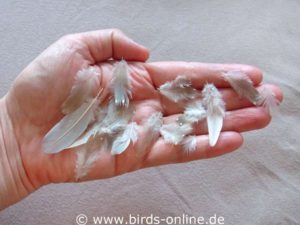- >>
- Birds Online – English
- >>
- Health and diseases
- >>
- Plumage disorders and moult
- >>
- Moult
- >>
- Fright moult
Fright moult

In the course of a regular moult, a bird renews its plumage, which is subject to natural wear and tear. Here, the loss of the old feathers takes place leisurely, they gradually fall out over a longer period. But things are different when it comes to a so-called fright moult. In this case, a sudden moult takes place as a result of an event (seemingly) threatening the birds concerned. In nature, fright moult for example happens then a predator captures a bird. By losing some feathers on the rump and tail, the bird may be able to escape. The predator will end up with only some feathers in his claws of talons. So this special type of moulting is a natural protective reflex of the bird’s body. Normally, the skin will not be harmed and there are no bleedings or at maximum just some traces of blood where the feathers have been growing.
It is often assumed that a bird who has lost his or her tail feathers can no longer fly. But this is not true. The tail feathers are used to stabilize the flight, for steering and braking. What they need for flying are the long feathers on their wings. If there are no tail feathers, flying is more difficult for a bird, but still possible. It can therefore be life-saving if, for example, a cat grabs the tail feathers of a bird, throws them off and flees. Even if this means having to fly under difficult conditions for a few days to weeks, it is the better option. In healthy birds, the feathers will grow back after a fright moult within a maximum of a few weeks.

Pet birds rarely experience a fright mouse. Typical situations in which it may happen are attacks by other pets such as cats or dogs. Or the birds are frightened when they are captured by the owner or by a vet to administer medicine, for example. Sometimes birds get frightened if little children grab them. But here is the good news: After a fright moult, a bird usually does not need to be taken to a vet, the feathers will most probably regrow on their own. If you don’t have to deal with a fright moult and several feathers have been torn out at the same time, you will find small wounds on the bird’s body. To be on the safe side, you should take your bird to an avian vet then.
The probability that a bird could suffer a fright moult is not the same for all bird species. Parrots and parakeets are generally relatively robust and in most cases are more likely to respond with shouting of protest or biting when you try to capture them. But some individuals are very shy and a fright moult could happen. One example of bird species that are prone to fright moult is the Diamond dove. These birds are usually very shy and rather anxious, which is why they often shed some feathers when you grab them with your hands.
